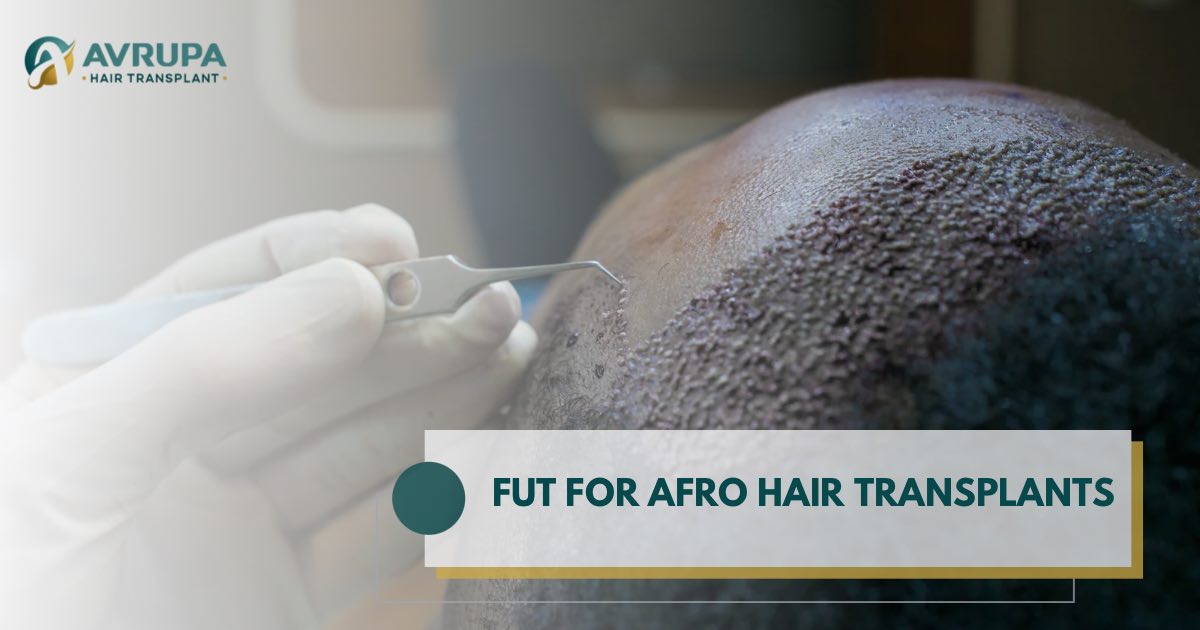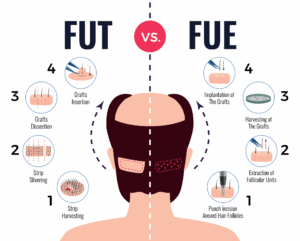
FUT for Afro Hair Transplants: Risks & Benefits

September 20, 2025 by
avrupahairtransplant
FUT for Afro Hair can still play a role in Afro-textured hair transplant, but only when you understand its trade-offs. A linear incision can deliver many grafts in one session, yet it also leaves a linear scar and raises special questions for people with tighter curls and a higher baseline risk of keloids.
This guide explains what FUT actually involves, how its scar compares with FUE dots, where FUT may be the right choice, how to plan density without wasting donor, and how to screen and care for keloid-prone skin.
What Is FUT (strip) and How Does It Differ From FUE?
In FUT, the surgeon removes a thin strip of scalp from the permanent donor zone, microscopically dissects it into follicular units, and then closes the incision. You get one linear scar rather than thousands of tiny dot scars from FUE. The main attractions are potential high graft yield per session and carefully trimmed grafts. The main costs: a line scar, the need for tension-aware closure, and a more visible tell if you later wear very short hair.

Linear Scar: What to Expect, What Controls Its Look
- Placement & width. The scar sits in the occipital/parietal donor zone. Width is affected by strip width, tissue tension, and closure technique. Wider strips and tight closures raise widening risk over time.
- Closure choices. Layered sutures commonly produce narrower, more comfortable results than staples in hair transplant donor lines; trichophytic edging can let hair grow through the scar for better camouflage.
- Lifestyle signaling. If you wear fades or very short styles, even a good linear scar can show under certain lighting/angles; with longer back-and-sides, it often blends.
Density Trade-offs: Where FUT May Help and Where It Doesn’t
- One-session yield. FUT can supply many grafts at once with precise microscopic trimming—useful if you need broad coverage and accept a line scar.
- Donor conservation. Because FUT harvests a strip from the most permanent zone, some surgeons pair FUT first, then FUE later, to maximize total lifetime grafts.
- Afro-specific angle. Afro hair often enjoys strong visual density thanks to curl and caliber; you typically don’t need extreme recipient densities to look full. Overpacking in any technique risks blood-supply problems; staged work is safer than forcing 60–70 grafts/cm² in one pass.
Keloid Risk in Afro Hair
Keloids are overgrown, raised scars that extend beyond the original wound and occur more often in people of African, Asian, or Hispanic descent. That higher baseline risk means FUT’s linear incision deserves extra caution; some patients are still excellent candidates, but only after proper screening and a prevention-first protocol.
Importantly, keloids can occur after hair transplant even with FUE (dot scars), although this complication is rare; the risk is not zero just because you avoided a strip.
A practical keloid protocol
- History & exam. Any personal/family keloids? Any thick, itchy scars after piercings or surgery? If yes, raise caution.
- Consider a small “test” area (when in doubt) to observe your healing response before a larger procedure.
- Closure choices that reduce tension (conservative strip width, layered sutures, trichophytic edge).
- Early scar care once closed: medical-grade silicone gel/sheeting to modulate scar thickness and color over weeks to months.
- Low threshold for treatment if the line itches, thickens, or raises: intralesional corticosteroid injections, often combined with 5-fluorouracil (5-FU), flatten many problematic scars more effectively than steroids alone.
If you’re considering African hair transplant procedure in Turkey but have concerns about scarring, it’s essential to work with a team that understands Afro hair biology and keloid risks. Our specialists use careful screening and prevention-first protocols to keep healing on track.
Who May Choose FUT Over FUE in Afro Hair?
Your hair transplant expert may choose FUT over FUE under these conditions:
- You prioritize maximum grafts in one sitting and normally wear longer back-and-sides, so a linear scar is less of a styling issue.
- Your surgeon advises FUT-first to preserve the “sweet spot” donor for later FUE and to optimize lifetime graft availability.
- You are not highly keloid-prone, or you’ve had similar incisions before that healed flat—and you agree to a proactive scar-prevention plan.
Who may avoid FUT: patients who prefer very short hair, have a strong keloid history, or simply prefer the dot-scar profile of FUE. Remember that FUE in coiled follicles demands curvature-aware punches and controlled motion to keep transection low; when done well, FUE can rival FUT yield without a line.
Planning Density Without Wasting Donor
- Frame the face first. Afro curl and caliber let you reach natural-looking forelocks/edges with moderate densities; don’t spend the bank on a first-pass crown.
- Respect the blood supply. Most scalps don’t tolerate ultra-dense packing in a single pass; safer to stage than to choke grafts.
- Future-proof. If your pattern may progress, hold a donor reserve for later; a flawless front with an empty donor is a bad trade.
FAQs
If I’m keloid-prone, is FUT Not Suitable for me?
Not automatically. Some patients still proceed with conservative strip width, tension-aware closure, silicone after closure, and rapid steroid/5-FU if thickening appears. For many, however, FUE is preferred to avoid a long linear incision. Discuss frank risks with your surgeon.
Could I get keloids from FUE dots instead?
It’s rare but documented. That’s why screening and follow-up are crucial, no matter which method you choose.
Does FUT always give more grafts?
FUT, often, yields many grafts efficiently, but your donor anatomy and the team’s technique decide. In Afro hair, an expert FUE approach with curvature-aware punches can also deliver high yields while avoiding a line.
Bottom line
FUT can be the right tool for Afro hair when you want large, efficient graft numbers and you’re comfortable with a well-planned linear scar, but it demands tension-aware closure and a keloid-prevention plan. If you’re highly keloid-prone or prefer close-cropped styles, FUE may fit better. Whatever you choose, insist on a surgeon who can explain donor math, show Afro-case results, and outline scar care (silicone, early steroid/5-FU if needed). That combination—smart selection, meticulous closure, and proactive aftercare—protects your donor and your result.
Written By
avrupahairtransplant
Avrupa Hair Transplant Clinic, Istanbul’s trusted name since 2006, transforms hair restoration with cutting-edge techniques like FUE, DHI, and Sapphire, crafting natural, lasting results. With over 40,000 success stories and a collection of international awards, Avrupa blends innovation with artistry, delivering personalized care that redefines confidence for clients worldwide.